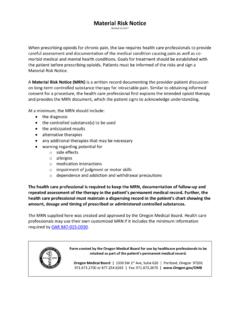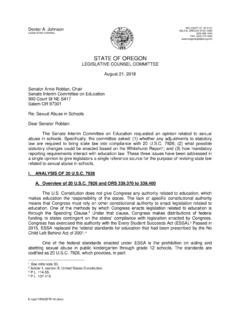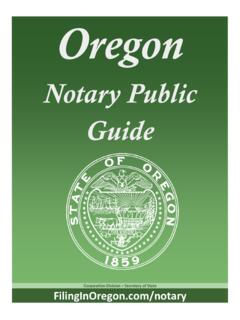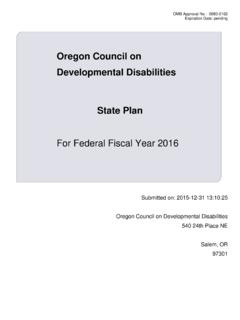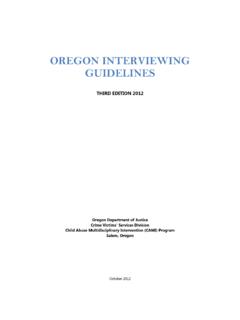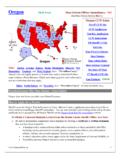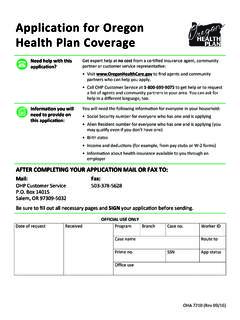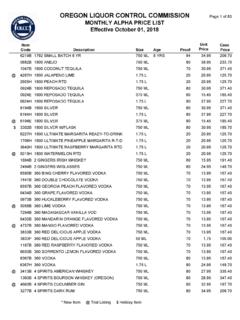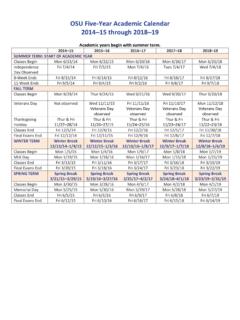Transcription of STATE OF OREGON
1 STATE OF OREGON TRAINING AND EXERCISE PLAN July 1, 2018 thru June 30, 2020 STATE of OREGON Multi-Year Training and Exercise Plan (MYTEP) July 1, 2018 through June 30, 2020 i TABLE OF CONTENTS Points of Contact ii Purpose & Methodology 1 Program Priorities 3 Supporting Training Courses 4 Training Schedule 6 Exercise Schedule 9 STATE of OREGON Multi-Year Training and Exercise Plan (MYTEP) July 1, 2018 through June 30, 2020 ii POINTS OF CONTACT (POCS) Exercise POC: Doug Jimenez STATE Exercise Officer OREGON Office of Emergency Management PO Box 14370 Salem, OR 97309-5062 503-378-3255 Training POC: Karen Layng STATE Training Officer OREGON Office of Emergency Management PO Box 14370 Salem, OR 97309-5062 503-378-3231 STATE of OREGON Multi-Year Training and Exercise Plan (MYTEP) July 1, 2018 through June 30, 2020 1 PURPOSE The purpose of the Multi-Year Training and Exercise Plan (MYTEP) is to document an organization/jurisdiction s overall training and exercise program priorities for a specific multi-year time period.
2 It is considered to be a living document that can be updated and refined annually. These priorities are identified by core capabilities, and are derived from analysis of existing strategic guidance, threat assessments, corrective actions from previous exercises, or other associated factors. Because of the geographical, cultural and industrial diversity in OREGON , there is no one set of standards that work in every community. The priorities are broad enough to allow all jurisdictions to plan activities that align with their individual priorities and requirements as well as with the priorities of the STATE . The MYTEP lays out a combination of training and a series of progressive exercises which address maintaining or developing the priorities identified in the Training and Exercise Planning Workshop (TEPW), which was conducted on April 6, 2018.
3 A progressive, multi-year exercise program enables organizations/jurisdictions to participate in a series of increasingly complex exercises, with each successive exercise building upon the previous one until mastery is achieved. Further, by including training requirements in the planning process, organizations can address known shortfalls prior to exercising capabilities. Included in this MYTEP is a training and exercise schedule, which provides a graphic illustration of the proposed activities, scheduled for July 1, 2018 through June 30, 2020. METHODOLOGY The planning process and methodology for the annual development of the TEP is conducted in three phases: Capabilities Assessment, Improvement Planning and conduct of the annual TEPW. A brief explanation of the three phases is provided below. Capabilities Assessment The Capabilities Assessment provides a gap analysis, by Core Capability, for each desired outcome and capability target identified in the STATE of OREGON Threat Hazard Identification and Risk Assessment (THIRA).
4 The Capabilities Assessment is conducted through a FEMA-defined 1-5 assessment rating for each POETE (Planning, Organization, Exercise, Training, and Exercise) element of each Core Capability; a set of standardized questions to guide the rating process; and a brief statement of gaps that must be filled in order to raise an element to a higher level of capability. Each of the 36 counties, the Urban Area Security Initiative (UASI) region and each STATE agency involved in STATE of OREGON emergency preparedness is required to complete an assessment. The rolled-up and analyzed data from the Capabilities Assessment is then used as one statewide assessment for STATE of OREGON . This assessment becomes the STATE of OREGON Stakeholder Preparedness Review. STATE of OREGON Multi-Year Training and Exercise Plan (MYTEP) July 1, 2018 through June 30, 2020 2 Improvement Planning After the Capabilities Assessment is completed, the next node in the Preparedness Cycle is determining the priority capabilities for the STATE of OREGON for the next two year s planned activities, to be reviewed and validated the following year.
5 Those priorities are based on the Department of Homeland Security 32 Core Capabilities definitions. Core Capabilities are prioritized each year goals are achieved other capabilities need to be addressed; therefore input from STATE and local stakeholders is used to determine where to prioritize efforts statewide. The second piece to the prioritization process is to identify why that capability is a priority by identifying the POETE element that best identifies the gap. POETE focuses the prioritization of Core Capabilities by asking is your priority determination because of a Planning gap, an Organizational gap, an Equipment shortfall, a Training need, or an Exercise validation? Training and Exercise Planning The purpose of the annual STATE of OREGON Training and Exercise Planning Workshop (TEPW) is to develop a Multi-Year Training and Exercise Plan (MYTEP).
6 The MYTEP identifies an entity s priorities as articulated in its strategy, and identifies the capabilities that are most relevant to achieving those priorities. The MYTEP then outlines a forecast of training and exercises that an entity will undertake to enhance and validate its capabilities. Prior to the annual TEPW, county, tribal, and STATE agency representatives are expected to forecast their anticipated trainings and exercises for the next two years. STATE of OREGON Multi-Year Training and Exercise Plan (MYTEP) July 1, 2018 through June 30, 2020 3 PROGRAM PRIORITIES The program priorities were set at the TEPW through a collaboration of effort by STATE , local, and tribal representatives. Analysis of information derived from the STATE Strategy, THIRA, Capabilities Assessment, and STATE Preparedness Report was provided to the attendees.
7 With this information, the attendees combined information from their own jurisdictional After Action Reports and Improvement Plans (AAR/IPs), capability gaps, and preparedness goals to develop a prioritized list of Core Capabilities that need to be either maintained or developed through planning, training, and exercise over the next two years. Though jurisdictions may conduct activities that include Core Capabilities that are not included in the Program Priorities, they are expected to include at least one of the Program Priorities in all of their activities. Operational Communications Ensure the capacity for timely communications in support of security, situational awareness and operations by any and all means available, among and between affected communities in the impact area and all response forces. Operational Coordination Establish and maintain a unified and coordinated operational structure and process that appropriately integrates all critical stakeholders and supports the execution of core capabilities.
8 Public Information and Warning Deliver coordinated, prompt, reliable, and actionable information to the whole community through the use of clear, consistent, accessible, and culturally and linguistically appropriate methods to effectively relay information regarding any threat or hazard and, as appropriate, the actions being taken and the assistance being made available. Community Resilience Lead the integrated effort to recognize, understand, communicate, plan for, and address risks so that the community can develop a set of actions to accomplish mitigation and improve resilience. Logistics & Supply Chain Management Deliver essential commodities, equipment, and services in support of impacted communities and survivors, to include emergency power and fuel support, as well as the coordination of access to community staples.
9 Synchronize logistics capabilities and enable the restoration of impacted supply chains. Mass Care Services Provide life-sustaining services to the affected population with a focus on hydration, feeding and sheltering to those who have the most need, as well as support for reunifying families. STATE of OREGON Multi-Year Training and Exercise Plan (MYTEP) July 1, 2018 through June 30, 2020 4 Planning Conduct a systematic process engaging the whole community as appropriate in the development of executable strategic, operational, and/or community-based approaches to meet defined objectives. Situational Assessment Provide all decision makers with decision-relevant information regarding the nature and extent of the hazard, any cascading effects, and the status of the response.
10 Critical Transportation Provide transportation (including infrastructure access and accessible transportation services) for response priority objectives, including the evacuation of people and animals, and the delivery of vital response personnel, equipment, and services into the affected areas. Public Health, Healthcare, & Emergency Medical Services Provide lifesaving medical treatment via Emergency Medical Services and related operations and avoid additional disease and injury by providing targeted public health, medical, and behavioral health support, and products to all affected populations. Supporting Training Courses: Training and Exercise program management involves a collaborative approach that integrates resources, organizations, and individuals in order to identify and achieve program priorities.


